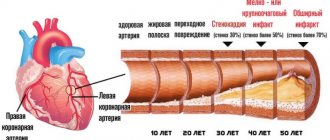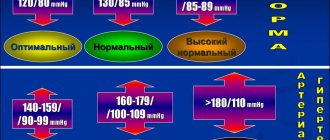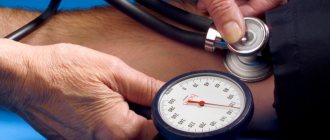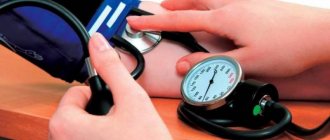Symptoms
Symptoms of pressure 100 to 80 are varied. Their presence at these indicators is not necessary; as a rule, signs appear at lower values. General signs:
- fatigue;
- drowsiness;
- weakness;
- headache;
- pallor;
- circles under the eyes;
- heartbeat;
- cold extremities;
- slower reaction;
- impaired concentration.
Symptoms depending on the severity of hypotension:
- With milder hypotension, the first symptom is headaches; this may cause dizziness.
- With severe hypotension, a person not only feels dizzy and has a headache, but also feels lightheaded.
- In extreme cases, blurred vision, cold sweat on the forehead, severe nausea, and short-term unconsciousness occur.
Important! When pressure drops, the body's compensatory mechanisms are activated - to ensure good blood circulation to vital organs, the body tries to regulate hypotension by increasing heart rate, slowing down peristalsis, and reducing urine excretion. .
Dangerous symptoms
If blood pressure is constantly kept within 100 to 80, a person needs an examination to identify the causes of developing hypotension, which can lead to a heart attack. To clarify the risk, experts advise focusing on the patient’s well-being - if the condition is satisfactory, there is no need to worry. If you notice the appearance of alarming signs that interfere with leading a normal lifestyle, you need to undergo an examination.
What are the symptoms of hypertension with low blood pressure:
- loss of strength and disturbed sleep, apathy, excessive sweating;
- decreased vitality, muscle weakness;
- interruptions in breathing, visual hallucinations;
- dizziness with nausea, fever.
Typically, hypotensive patients complain that they have a headache in the forehead, pulsation and pain in the temples. Due to hypoxia (oxygen deficiency), patients are susceptible to fatigue, problems with memory and attention appear, which reduces performance and traumatizes the psyche. Due to impaired coordination of movement, loss of consciousness is possible, which increases the risk of injury.
What to do
There is no need to worry if the patient:
- feels satisfactory;
- does not feel anxiety, weakness, fatigue, nausea, dizziness, headache;
- makes no other complaints.
If the opposite is true, you need to:
- Place the person on their back with their legs elevated. This increases blood flow to the brain, which avoids adverse consequences.
- Give access to fresh air. For this purpose, you can open a window.
- Drink sweet tea or coffee. These drinks help increase vascular tone, which increases blood pressure.
- Eat any sweets as an additional source of glucose.
- Use herbal preparations based on lemongrass, eleutherococcus, and ginseng. They have a general strengthening and tonic effect and help normalize blood pressure.
- Take a contrast shower, which also has a beneficial effect on vascular tone.
And also read on our website what to do if your blood pressure is: 100 over 50, 100 over 70, 100 over 90 and?
If the pressure of 100/80 is accompanied by the symptoms mentioned earlier and disrupts the usual way of life, then you should consult a specialist. Doctors usually prescribe:
- caffeine-based medicines;
- drugs that stimulate the nervous system;
- herbal medicines;
- complexes of vitamins, minerals and trace elements.
The doctor must conduct a survey, finding out:
- severity of symptoms, their duration;
- pre-existing conditions that could cause a decrease in blood pressure levels;
- the presence of chronic diseases that may be the basis of this condition;
- aspects of lifestyle, presence of bad habits;
- presence of pregnancy.
If your blood pressure is 100 over 80, this is a hypotensive condition for you, then you should remember that you need to consult a doctor, as there may be a risk of serious consequences. These include:
- chronic cerebrovascular accident;
- ischemia of the heart muscle;
- myocardial necrosis resulting from trophic disorders;
- fainting conditions;
- anemia.
To avoid hypotension you should:
- Normalize your daily routine. It is important not only to work, but also to fully rest. This allows the body to gain strength.
- Maintain a sleep schedule. To replenish energy, the body requires sleep, which should last at least 8 hours.
- Balance your diet. Eating rationally in small portions at least 5 times a day will help keep the body in good shape.
- Remember about physical activity. Movement is life. By leading an active lifestyle, you can avoid many dangerous diseases.
- Spend more time outdoors.
- To refuse from bad habits.
- Reduce the number of stressful situations.
The reasons for this decrease in blood pressure
The pressure readings are not constant throughout the day. Understanding what such a pressure drop means and what its causes are is the key to successful treatment.
The reasons for such a failure are varied. They are individual, depending on the lifestyle of a particular person, the presence of certain diseases, and nutrition. Thus, the following factors are distinguished:
Pathological. These include heart disease, neurological disease, kidney and heart disease, exhaustion, failure, infection, bleeding, and the use of certain medications such as antidepressants and painkillers.- Non-pathological. These are age, pregnancy, bed rest, professional sports, fever. These also include genetic predisposition, acclimatization period, and ambient temperature. Blood pressure is affected by a number of psychological reasons: a person’s emotional state, stress, and the presence of bad habits.
What does pulse pressure mean?
Increased pulse pressure is often observed in people suffering from hypotension. This may indicate vascular disease and ischemic disease, more often tachycardia. It can be calculated by subtracting the “lower” pressure from the “upper” pressure reading. That is, with a blood pressure reading of 100/80, it is 20 beats per minute. But what if the pulse is 100 beats per minute?
To normalize your heart rate, stop activity and relax. Try to breathe deeply and calmly, unfasten tight clothing, and wash with cold water. Take valerian, if there are no contraindications or intolerances to it, open the window to let fresh air in. If your pulse does not return to normal, seek medical help and call an ambulance at home.
conclusions
People's blood pressure levels vary. But even if, with the usual indicator of 120 to 80, the upper pressure dropped by 20 units, then there is no need to panic. There is no threat to life in this case.
You need to focus on your well-being. If the general condition of the body is good, then everything is in order, and the device readings of 100 to 80 are normal.
For some people, living with low blood pressure is natural. But a state of anxiety with high heart rates indicates that you need to take a sedative.
If attacks of low blood pressure occur more often, and they are accompanied by the unpleasant sensations described above, then consultation with a doctor is necessary.
Regular medical examinations will help identify serious problems in the early stages. This will allow the body to quickly get back on its feet.
What does a high or low heart rate indicate?
Not much. Heart rate and blood pressure monitor levels are not related. Although the correlation is obvious, it does not exist.
However, the pulse can be used to assess the danger of the process, the need for hospital treatment and the prospects for recovery.
Sinus-type tachycardia (90-100 beats or more while maintaining the correct rhythm and intensifying the work of the natural driver) requires correction of the underlying disease. The acceleration of cardiac activity in itself does not pose a danger.
The paroxysmal type of tachycardia (paroxysmal) is associated with the threat of cardiac arrest and sudden death.
Fibrillation, fluttering, as well as group extrasystoles such as bigeminy and trigeminy, which are recorded during the ECG, provoke a fatal result even more often.
Bradycardia, that is, a decrease in heart rate of less than 60 beats per minute indicates a violation of tissue conductivity or a weakening of myocardial contractility. The prognosis is getting worse.
This is an indirect connection, mostly noted as a result of organic disorders of the heart and blood vessels.
Causes of pathology
The following factors influence blood pressure readings:
- excessive physical activity;
- hereditary predisposition;
- insufficient amount of iodine in the body;
- overwork;
- nervous breakdowns;
- stimulants contained in coffee and tea;
- misuse of medications;
- unsuitable climatic conditions;
- hormonal disorders in pregnant women;
- obesity;
- chronic diseases;
- poor nutrition;
- weather changes (atmospheric pressure surges);
- alcohol and smoking abuse.
The lack of difference between the lower and upper pressure indicators poses a serious threat to life. During this period, a person needs urgent hospitalization and examination.
What does pressure 10080 mean?
Detection of low blood pressure may indicate the following:
- the person is hypotensive;
- an acute attack of hypotension developed;
- when systolic pressure is below 90 – the patient is in a state of shock, there is a violation of microcirculation and tissue metabolism.
Reduced numbers are also detected in children under the age of 16–17 years, which is a physiological condition and is not life-threatening.
The diagnosis of hypotension is established based on repeated measurements of the patient's blood pressure on different days and times of day. In the absence of complaints and pathological symptoms, a person can live a full life without treatment.
Acute attacks of hypotension occur in various conditions, such as:
- injuries to the brain or medulla oblongata;
- metabolic disorders (diabetes mellitus, ketoacidotic coma);
- contusion of the heart muscle;
- pericardial hemotamponade and others.
A chronic physiological decrease in blood pressure is a characteristic feature of tall people with low body weight (asthenics). Their peculiarity is the frequent presence of connective tissue diseases, decreased body reactivity, and a tendency to motion sickness.
Methods for correcting the condition
If you feel good with low blood pressure, there is no reason to worry. If you feel dizzy and have a headache, other symptoms of hypotension appear, and your pulse is 90 or higher, you should take measures to improve your well-being. To do this you need:
- take a comfortable position and relax, since an attack of hypotension can be triggered by nervous overstrain;
- do not make sudden movements, drink caffeine-containing drinks or alcohol in large doses in the hope that the condition will stabilize;
- take 20 drops of Volocordin diluted with water, valerian or motherwort tincture;
- relieve headaches with Citromon tablets that slightly increase blood pressure.
After 15 minutes, pressure and pulsation will return to normal. After stabilizing your condition, you should consult a doctor who will answer the question of why your blood pressure has dropped in your case, and will be able to prescribe a treatment regimen and give recommendations regarding physical activity and the optimal daily routine.
Blood pressure levels can depend on chronic diseases, age and even the weather. If a decrease in pressure brings discomfort and disrupts the usual rhythm of life, it is worth contacting specialists who can identify and eliminate the causes of the disorder.
What is pressure, what is its norm
Based on blood pressure (BP) indicators, a person’s health status is judged. During the measurement process, a tonometer is used to determine the force of pressure on the walls of blood vessels, which is pushed out of the organ cavity by the heart muscle. The concept of measurement is based on obtaining two digital values, the difference between which also has a certain meaning.
| Indicator name | What does the value indicate? |
| Systolic | The number corresponds to the pressure inside the arteries at the moment the heart is compressed and blood is pushed into their cavity at the systole stage. The value called upper blood pressure is recorded first when recording the results on paper. This indicator always exceeds the next (diastolic) value. |
| Diastolic | The number corresponds to the pressure force of the blood flow at the moment the heart muscle enters the relaxation phase. This is the minimum indicator of pressure in the arteries, reflecting the degree of stability of the blood vessels (peripheral). The value is written second after the upper blood pressure digit. |
| Pulse difference | The value, which is the mathematical difference between the upper and lower values, is usually not recorded on paper, but its figure is taken into account. It should be within 30-40 units, measured in mm of mercury, like the pressure itself. |
The level of blood pressure in a healthy person is relatively stable, but is subject to fluctuations under the influence of events in everyday life. The dynamics of changing values can be called a hint about the onset of pathological changes in the functioning of the heart and the condition of blood vessels.
Important: A pressure of 100 to 80 means that insufficient blood circulation has caused oxygen starvation of the heart muscle. This is manifested by too small a difference between the systolic and diastolic components of blood pressure, which may be a signal of the development of hypotension
What numbers correspond to the norm?
For each person, the concept of normal blood pressure values is purely individual, based on the state of health and characteristics of the body. The norm for the average person, not burdened with serious pathologies, is considered to be a blood pressure of 120/80.
There is no consensus among doctors regarding the pulse difference - some experts consider it a serious aspect, others have doubts about the importance of the figure. In the process of medical practice, doctors discovered a certain pattern:
- in the working population, the difference between blood pressure values can be 20-60 mm Hg. Art. both with values of 100/80 and with values of 120/60;
- in older people susceptible to hypertension, fluctuations in the difference signal an impending catastrophe of a vascular, cerebral or cardiac scale.
To obtain reliable information about your blood pressure level, you must measure it correctly. Measurements should be taken daily, at approximately the same time of day. An hour before the measurement, do not drink invigorating drinks (coffee, alcohol), as well as certain types of medications, and stop smoking. The measurement is performed twice with an interval of 2-3 minutes, sitting quietly without tension.
What pressure is considered normal?
The norm of blood pressure is individual; on average, its optimal value is considered to be 120/80. You can find out the optimal values if you take into account the patient’s age, weight and gender. The average values for adult men and women differ, and blood pressure can rise or fall with significant differences throughout the day.
To measure blood pressure, a tonometer is used, using millimeters of mercury as units of measurement. To get the right result when working with it, you should follow a number of simple rules:
- Take measurements at the same time.
- Avoid drinking alcohol, coffee, certain medications and smoking for 1 hour before measurement.
- Take measurements while sitting, in a quiet environment, after a short rest.
- Measure the pressure several times at intervals of 2 minutes.
The effect of age on blood pressure
Continuing the study, taking into account the above information, we will try to establish: is the above blood pressure value - 100/80 - the norm?
Blood pressure largely depends on age. So, let's look at blood pressure standards by age. In infancy, for example, for one-year-old babies 96/66 is the norm, also the norm for men from 40-49 years old is 135/83, and for old people 80 years of age and above, their own norm is 147/82. For women, these figures are slightly lower - by 5-10 units. During pregnancy, blood pressure is often elevated. It changes several times during the day. Its indicator depends on many factors:
- One-time physical activity and sports lead to increased blood pressure.
- Taking medications can lead to both an increase and a decrease.
- Time of day - at night blood pressure is lower.
- Taking stimulants, such as alcohol, tea, coffee - an increase followed by a sharp decrease.
- Psychological state: stress provokes surges in blood pressure.
It is noteworthy that one-time maximum loads usually lead to an increase in blood pressure, and with stable high physical activity, when the body gradually adapts to it, blood pressure normalizes and even decreases slightly.
Blood pressure 100/80 - in pregnant women, elderly people (usually a consequence of high cholesterol), in men (their norm is usually higher than in women) - can be considered a sign of hypotension or, more correctly, hypotension. True, initial level. Arterial hypotension (hypotension) is a concept meaning low blood pressure. This is a “beacon”: the tone of blood vessels and muscles is reduced.
Treatment of low blood pressure
Pharmacological drugs, vitamins and folk remedies effectively help treat hypotension. It is better if the necessary medications are prescribed by a doctor after conducting a preliminary examination. At home, you can prepare proven folk remedies and follow a balanced diet containing useful elements and vitamins. Timely treatment of hypotension significantly increases the chances of improving the condition.
Pills
Medicines prescribed for hypotension mostly contain caffeine, like the widespread citramon, and extracts of medicinal plants: eleutherococcus, ginseng, Rhodiola rosea, Echinacea. Common pharmacological drugs will help cure the disease: fludrocortisone, mezaton, strophanthin, camphor.
Vitamins
Vitamin therapy has proven itself excellent for hypotension. B vitamins counteract chronic fatigue, improve the body's resistance to stress and high physical activity, and help normalize blood pressure. For concomitant migraines, it is recommended to use brewer's yeast and vitamin E for two weeks.
Folk remedies
What does medicine recommend to drink for low blood pressure?
- Coffee, strongly brewed tea, chocolate and red wine are effective in moderation.
- Decoctions of medicinal herbs - ginseng, eleutherococcus, elecampane - fight hypotension by improving vascular tone. Expectant mothers can drink cranberry or birch juice, pumpkin broth with honey during the day.
Why might blood pressure drop?
A value of 100 to 80 is not considered normal, but predicting serious pathologies only based on blood pressure and pulse differences is unacceptable. To understand the cause of this condition, you will have to monitor your blood pressure over time, not forgetting to measure your pulse along with your blood pressure. In addition, biochemical blood testing is important.
Low blood pressure in a healthy person
100/80 is not considered a characteristic sign of hypotension, but if a pressure of 120-125 over 80-85 is considered normal for a patient, it is worth thinking about the reasons for the appearance of low numbers. The presence of episodic fluctuations in blood pressure can be explained by external influences; if the drop in the indicator becomes regular, you should look for possible health problems associated with other reasons:
- extensive blood loss, symptoms of dehydration;
- consequence of the development of vegetative-vascular dystonia;
- signs of abnormal heart valve function;
- lack of adrenal and thyroid hormones;
- the development of thromboembolism as a result of heat stroke.
Deviation of pressure from the norm in the downward direction is more often found in adolescents and the elderly. In women during pregnancy, it is subject to fluctuations; a decrease to a level of 100 to 80 may indicate hormonal changes, the development of heart or kidney pathology. But it is not recommended for pregnant women to take medications that increase blood pressure on their own, so as not to harm the fetus.
Blood pressure indicators in preschool children are at the level of 95/60 mmHg. Art., which is considered normal, and their increase to 100 units by 80 already borders on a sign of the onset of hypertension. Men are characterized by higher units, which may fall due to an overdose of drugs for hypertension, in case of problems with heart function.
A table of pressure indicators for a relatively healthy person is given below.
Important: A small pulse difference is especially dangerous, which can signal a weak heart and an increased risk of a heart attack. No treatment is given for physiologically low blood pressure
100 to 80 in hypertensive patients
If, during the treatment of hypertension, a patient’s blood pressure drops to one hundred units, this is a signal that it is necessary to adjust the list of drugs used to treat hypertension. Also, the cause of a drop in blood pressure may be associated with the following factors:
- post-stroke period, in this case it is important to monitor the pulse, it may increase;
- overdose of antihypertensive drugs used to reduce high blood pressure units;
- increased physical activity of a hypertensive patient who is unaware of his pathology.
In hypertension, low blood pressure is often recorded during waking hours, which is manifested by a sudden loss of balance due to dizziness. A person may even lose consciousness due to such a jump. If you have a similar symptom without measuring your blood pressure, you should not immediately take a pill that lowers it, this will only worsen the condition.
100 to 80 and high pulse
The pulse reflects the heart rate; 80 beats per minute is considered normal. If, with low pressure, the pulse rises to 100 beats or higher, this is a possible onset of tachycardia, which accompanies psychosomatic disorders. A drop in blood pressure with an increase in heart rate can be observed in men who are professionally involved in sports, as well as under stress or taking antidepressants.
Please note: Tachycardia when the pressure drops to 100 to 80 can result in shock due to a deterioration in the ability of the cardiovascular system to get rid of carbon dioxide and metabolic products. This condition poses a threat of death
What to do to correct blood pressure
An asymptomatic drop in blood pressure to 100/80 does not suggest any treatment. The appearance of weakness and dizziness indicates the need for a little rest. And only serious negative symptoms can become a reason to take medications.
At home
The following simple steps are enough:
- no sudden movements, rest, loosen tight clothes, wipe your face with a damp towel, get comfortable, if you are lying down - a cushion under your feet;
- you can take sedative drops: Corvalol, Motherwort, Valocordin;
- if you have a headache, take Citramon;
- have a cup of sweet tea.
If there is no result, medical help is needed; self-administration of hypertensive medications will raise both upper and lower blood pressure, and this threatens the development of serious complications: bleeding, intoxication, shock.
Medicines
Drugs that increase blood pressure are taken only after agreeing on a treatment regimen with a doctor. The most effective ones are presented in the table.
| Group of drugs | Properties |
| Alpha adrenergic agonists: Gutron | Rapidly increases blood pressure, increases tension in the vascular walls |
| Adaptogens: Eleutherococcus, Leuzea | Herbal hypertension with minimal side effects |
| Analeptics: Sydnofen | Relieves symptoms of hypotension |
| Anticholinergics: Platiphylline | Block acetylcholine |
| Caffeine containing: Caffeine benzoate | Increases vascular tone |
| Homeopathy: Gelsemium 15 | Placebo |
| Vitamins: C, B12 | Improve tissue nutrition |
Treatment regimen
Therapy is carried out from several positions and is designed to solve a group of problems.
Eliminating the root cause is the main point, since pressure of 100 to 80 is only a symptom. Here the field of activity is vast, everything depends on the patient’s condition and the underlying pathological process.
A few examples: anemia can be eliminated by the use of vitamins and iron; renal abnormalities require surgery or the prescription of medications, etc.
Symptomatic treatment consists of relief of manifestations. A number of pharmaceuticals are used to restore pulse pressure:
- Antihypertensive in combination with vascular tonic medications. The selection of the regimen is carried out with great care; disturbances in cardiac activity, myocardial contractility and other processes are likely.
- Antiarrhythmic. As needed. Amiodarone as the main one. In a strictly adjusted dosage, no more, to avoid dangerous side effects.
- Cardioprotectors.
- Diuretics are used less frequently.
Smoking and alcohol consumption are contraindicated throughout the treatment. Diet does not play a big role, all doubts are discussed with a nutritionist, and in the absence of the opportunity to consult with him, with a regular attending physician.
What needs to be examined?
Diagnosis is carried out under the constant supervision of a cardiologist. It is possible to involve third-party doctors as needed.
The primary scheme is:
- Oral questioning of the patient regarding complaints. As a rule, there are a minimum of them, and if they are present, they are nonspecific.
- Anamnesis collection. Habits and family history play a big role.
- Measurement of blood pressure, heart rate in combination.
- Daily Holter monitoring using an automatic tonometer. Records the same indicators for 24 hours. Makes it possible to evaluate states over time.
- Electrocardiography. Records arrhythmias of various types and severity.
- Echocardiography. Determines organic defects in heart structures.
- Load tests. Carefully. Limited to bicycle ergometry.
Identification of etiology is possible using other methods. They are shown later if there is no evidence for purely cardiac conditions. Sample list:
- Ultrasound of kidneys, glands.
- Chest X-ray.
- MRI or CT, the former is preferable.
The regimen can be adjusted at the discretion of doctors. This is not a dogma, but just a rough template.
Possible complications
Outside of therapy or with an insufficiently high-quality regimen, the following consequences may occur:
- Heart failure. As a result of a drop in output, blood stagnation and a decrease in myocardial contractility.
- Stroke. Acute malnutrition of cerebral structures. Potentially fatal condition.
- Heart attack. Necrosis of the muscle layer. Leads to deficiency, dysfunction and lifelong disability. The possibility of death always looms on the horizon.
- Cardiogenic shock. Carries the greatest danger. Even with timely assistance, no one guarantees the patient’s life. Statistics show that death occurs within 3-4 years, which happens less in almost 100% of people. The cause is a repeated episode of cardiac arrest or massive heart attack.
- Vascular dementia. As a result of constant disruption of nutrition of cerebral structures. Forms a clinical picture similar to that of Alzheimer's disease.
What to do if blood pressure drops?
The following measures will help as first aid:
- get up slowly from a lying position;
- in case of dizziness, bend over, placing your head between your knees;
- For moderate to severe hypotension, loosen clothing around the neck and wipe your face with a cold towel;
- for more severe hypotension, lie on the floor, raise your legs - the blood will move to the torso and head, the condition will quickly return to normal;
- if the cause of a sharp drop in blood pressure is obvious (for example, taking large doses of medication or massive bleeding), call an ambulance immediately - hypotension in this case means shock or intoxication.
What does pressure 100 over 80 mean?
A score of 100/80 is not normal. Low upper pressure of 100 is a reason to be more attentive to your health and consult a doctor for further consultation. The systolic value is less than 90-100 mmHg. Art. often means a symptom of hypotension - low vascular tone. Indicators of 100 to 80 may be safe for young people in the absence of associated complaints. Low upper blood pressure in older people and poor health requires an immediate call to the ambulance.
The reason for low blood pressure of 100 to 80 is the insufficient power of the heart muscle to pump blood through large-diameter vessels. The first signs of a hypotensive state are headache and increased fatigue. Hypotension can be caused by the body’s adaptation to some new conditions or be a symptom of more serious diseases. In both cases, you should think about how to raise low blood pressure.
Frequent causes of physiological low blood pressure that do not require additional treatment are high physical activity in athletes and adaptation to a new climate. In pregnant women, hypotension is explained by the appearance of an additional circulatory system and changes in hormonal levels. Hypotension in pregnancy requires close monitoring because it jeopardizes the development of the baby.
Causes of hypotension caused by disruption of the normal functioning of the body:
- blood loss and dehydration, which reduce blood volume;
- deterioration of blood circulation due to atherosclerotic manifestations and vegetative-vascular dystonia;
- abnormal heart valve function;
- insufficiency of adrenal and thyroid hormones;
- thromboembolism;
- heatstroke.
Why is it dangerous?
Low blood pressure requires diagnosis because it can be a symptom of serious illness. Hypotension can be considered one of the symptoms of an impending heart attack. Consequences of insufficient oxygen supply to the body during hypotension:
- dizziness and loss of consciousness with risk of injury;
- memory impairment;
- weakened attention;
- decreased resistance to physical activity, general weakness;
- impaired coordination.
What do the indicators mean?
A diagnosis cannot be made based on blood pressure measurements alone. To do this, it is necessary to carry out appropriate monitoring. In addition, you will need to analyze not only blood pressure, but also other indicators. What does blood pressure 100/80 mean?
For pregnant
During pregnancy, a woman's body undergoes significant changes in all systems. The heart and blood vessels are no exception. Blood pressure readings of 100 over 80 during pregnancy are normal.
If these values are individually low for the expectant mother, then moderate hypotension is accompanied by symptoms such as:
- noise in ears;
- dyspnea;
- dizziness;
- drowsiness;
- darkening of the eyes.
In this case, the pregnant woman will need:
- assistance from a general practitioner and gynecologist;
- correction of the daily routine;
- maintaining proper nutrition.
Otherwise, a hypotensive state may threaten the development of:
- preeclampsia;
- placental insufficiency;
- fetal hypoxia;
- onset of premature labor.
For adults and seniors
Despite the fact that throughout the world the normal blood pressure for an adult is 120 over 80, readings of 100 over 80 are also considered normal . This is due to the individual characteristics of each organism.
For children and teenagers
A pressure of 100 over 80 for children under 10 years of age is considered elevated due to the diastolic indicator, which at this age should be maximum 75. The reasons for the increase in diastolic pressure may be:
- organic damage to the renal vessels;
- lumbar region injuries;
- congenital heart valve defects;
- disturbances of rhythm and impulse conduction through the myocardium;
- diseases of the endocrine system;
- genetically determined predisposition.
For teenage children, the blood pressure value is 100/80 mmHg. considered the norm.
Is it dangerous
To conclude whether pressure 105 over 65 is dangerous, you need to understand the reason for such indicators. There are two types of hypotension - primary and secondary. There are isolated cases of low blood pressure, as well as a physiological norm.
Primary hypotension
It is characteristic of neurotic ailments and occurs most often when people suffer from weather dependence and lead a sedentary lifestyle. Their performance remains at a normal level only in the first half of the day; later they are plagued by lethargy, apathy, and reluctance to do anything. This is not life-threatening, but it is advisable to take measures to increase blood pressure to improve your well-being.
Secondary hypotension
Develops in acute infectious diseases, blood loss (including internal bleeding), prolonged diarrhea, chronic infections and intoxications, as well as serious illnesses associated with immobility, nutritional disorders, and hypovitaminosis. In such cases, the cause of low pressure should be addressed.
Physiological norm
If we see low indicators, while feeling normal, then we are dealing with a physiological norm. This is clearly seen in the study of arterial parameters in adolescents and young people under 30 years of age. Only 5 percent of the subjects had low blood pressure, while a third of them did not reveal any disorders or abnormalities in their body.
If a temporary phenomenon
Sometimes hypotension is temporary and isolated, when a person is simply overheated in the sun and does not drink enough water. As a result of dehydration, the body compensates for the lack of fluid with blood, so the pressure drops sharply. Sunstroke and heatstroke are always accompanied by hypotension and these are very dangerous conditions for humans.
Rules for measuring blood pressure
Treatment
Most often, as part of treatment, lifestyle changes, improved nutrition, and drinking regimen are recommended. You can, but with caution, increase your sodium intake. Physical activity is also beneficial. It is advisable to wear elastic stockings to prevent blood clotting.
Pills
In more severe cases, medications that increase tension in the vascular walls can be prescribed.
One of the drugs is Gutron, available in tablets or drops, available by prescription. The effect of the drug is slow, it does not have a negative effect on the brain, unlike the previously used Ephedrine.
Among homeopathic remedies, Gelsemium 15 is recommended.
Vitamins
Hypotonic patients are advised to increase their intake of vitamins C and B12:
C – improves blood supply to organs;
B12 – its deficiency causes anemia, a common cause of low blood pressure.
Folk remedies
Traditional medicine for hypotension recommends infusions of the following herbs (1 tsp of raw material per 1 tbsp of boiling water, drink 1-2 times a day):
- Eleutherococcus;
- Gynostemma spotted;
- Chinese cordyceps;
- ephedra;
- fir;
- Sophora;
- plantain;
- common shepherd's purse;
- gorse;
- magnolia;
- Orlaia grandiflora;
- sea buckthorn;
- rosemary;
- savory;
- knotweed;
- ginseng.
How to prevent the situation from getting worse
When your blood pressure is 110 over 80, it is very important to make a few adjustments to your lifestyle. This will help improve the condition and prevent the progression of hypotension
Rules for living when blood pressure deviates from the norm:
- Active lifestyle. Play sports or get into the habit of walking in the evenings. This will significantly improve the condition of the body.
- Stop smoking. The results of this innovation will be noticeable almost immediately.
- Normalize your sleep. Sleep at least 8 and no more than 12 hours a day. It is also advisable to take a fifteen-minute rest every two hours of hard work.
- Maintain drinking regime. To calculate your fluid intake, you need to multiply your weight in kilograms by 30 ml.
- Avoid stress. Try not to get into conflict situations or create them.
- Eat right. Avoid fried, fatty and low-quality foods. Avoid drinking alcohol. Eat plenty of fresh vegetables, fruits and dairy products.
- Get rid of everything unnecessary. To improve your condition, you need to fight extra pounds. However, strict diets are prohibited. The best way to lose weight is proper nutrition and exercise.
A pressure of 100 over 80 is a non-critical indicator . Separately, such values of systole and diastole are within the normal range. However, due to low pulse pressure, such blood pressure has a negative impact on health and may be a symptom of problems within the body. Therefore, it requires consultation with a specialist.
Changing your lifestyle is the key to restoring blood pressure
What should I do to normalize my blood pressure? At the initial stage of the disease and in addition to the main method of treatment, the doctor always recommends paying attention to the person’s lifestyle. The patient should make changes in the following areas:
- reduce salt intake;
- play sports (running, swimming, aerobics);
- reduce alcohol consumption or give it up altogether;
- if a person is overweight, then measures must be taken to normalize it;
- minimize the consumption of invigorating drinks (coffee, black tea, energy drinks);
- learn to eat right, give up fatty, fried, smoked and fast food;
- stop smoking;
- try to control individual psycho-emotional health.
By following simple rules, a person can normalize blood pressure, which will lead to good health. During treatment, it is important to follow all the specialist’s recommendations and study the instructions before using any medications. It is important not to self-medicate so as not to harm your health - it is better to trust the professionals!
Features of secondary hypertension
Symptomatic decrease in pressure can be acute (vascular collapse) or chronic. A sudden and sharp decline occurs when:
- injuries, especially if they are accompanied by severe bleeding;
- infections;
- significant loss of fluid (vomiting, diarrhea);
- allergies.
A significant decrease in pressure occurs in heart failure, especially with extensive myocardial infarction. In this case, the work of the heart muscle is disrupted, and the heart stops pumping blood into the vessels properly.
The development of hypotension is also facilitated by taking certain drugs that affect vascular tone and the functioning of the autonomic nervous system:
- antihypertensive medications;
- medications used for anesthesia;
- barbiturates;
- phenothiazines.
An acute drop in blood pressure is dangerous due to the development of shock. Chronic hypertension is observed in various diseases. Most often, low blood pressure occurs due to:
- disorders of the adrenal glands;
- hypothyroidism;
- atherosclerosis;
- heart and vascular defects;
- rheumatism;
- anemia;
- hypovitaminosis (with a lack of B vitamins).
Secondary hypotension is cured along with the underlying disease.
Features of orthostatic hypotension
A drop in blood pressure occurs when the body moves from a horizontal to a vertical position. This may even cause fainting and convulsions. If you measure blood pressure in a supine position in patients with orthostatic hypotension, it may even be elevated. But when standing up, the pressure drops sharply by more than 20 mm Hg. Art.
This type of hypotension occurs:
- with varicose veins;
- in late pregnancy;
- after taking certain medications (clonidine, ganglion blockers, prozosin, nitrates, etc.);
- due to significant fluid loss (severe bleeding, diarrhea, vomiting, copious and frequent urination);
- after prolonged bed rest.
A characteristic feature of orthostatic hypotension is tachycardia. In addition, the symptoms of the disease intensify in hot weather, after physical exertion.
It is important to know! If hypotension is detected when measuring blood pressure, you should immediately consult a doctor. Only a specialist will accurately determine whether the decrease in pressure is physiological, symptomatic, or a separate disease. And treatment can be prescribed only after an appropriate examination.
odavlenii.ru
What does low upper pressure mean?
Upper blood pressure can drop at any age. Doctors call low blood pressure hypotension. Hypotension is a disease during which normal values decrease by 20% or more. That is, systolic pressure is 90 mm or lower.
Hypotonic people often react to weather conditions and atmospheric pressure. During bending, sudden jumps and other changes in the body, patients feel dizzy and have difficulty oriented in space. From a prolonged stay in a sauna or bathhouse, or from long walking, such people may suddenly lose consciousness.
A person who has low upper blood pressure may begin to choke and faint while standing on public transport. At such a moment, it is advisable for him to sit down so that his head rests on his knees.
People with low blood pressure feel tired in the morning
Interruptions during night sleep are also a sign of low blood pressure. During the day, hypotensive people really want to sleep, they get up hard in the morning, they experience an irritable state, and after waking up they feel as if they had not rested at all.
Low systolic pressure and high pulse: what does this mean?
Systolic blood pressure and pulse are very important factors. Thanks to them, you can find out the general condition of the whole body and the cardiovascular system. If changes occur in the human body, the indicators of upper pressure and pulse will certainly show this.
You will be able to understand immediately if something happens to your upper pressure and pulse, as the following symptoms appear:
- Heaviness, pain in the abdomen in the stomach area.
- Pain behind the sternum.
- Your head will start to feel dizzy.
- Drowsiness and weakness will occur.
There is heaviness in the stomach.
Low systolic pressure and high pulse can occur due to tachycardia and hypotension. Often the problem lies in the high use of medications. The following medications can negatively affect the heart and the entire vascular system:
- Antidepressants.
- Diuretic medicine.
- Medications that lower blood pressure.
In addition to medications, this condition can be caused by:
- Large blood losses.
- Severe bleeding.
- Dehydration of the body.
- State of shock.
- Excessive consumption of nicotine and alcoholic beverages.
- Avitaminosis.
- Inflammation of internal organs and many others.
Main reasons
The diastolic form of hypertension sometimes develops due to the influence of external factors. In this case, it occurs periodically, does not require emergency treatment and goes away after eliminating a certain factor that provoked its appearance.
Most often the reasons are the following:
- emotional overload;
- iodine deficiency in the body;
- hereditary factor;
- hypovitaminosis;
- too much weight;
- frequent drinking of alcohol;
- failure of the hormonal system;
- poor quality and irregular nutrition;
- frequent stressful situations;
- taking antihypertensive drugs;
- excessive use of salt in the diet;
- sedentary work that requires a long stay in one position;
- frequent overeating;
- fatigue.
In pregnant women
The reasons for such changes in pregnant women can be completely different. These may be hereditary diseases of the heart, kidneys, hormonal system disorders, fear of the upcoming birth. In later stages, blood pressure may fluctuate due to frequent climbing of stairs or due to an extra cup of morning coffee.
In adults and older people
The most common causes of pressure 100/100 in adult patients are an adverse reaction to taking certain medications, internal bleeding or injury, hormonal changes, and the presence of cancer. Smoking also greatly affects this.
In children and adolescents
In the younger generation, blood pressure may change due to genetic predisposition, during climate change, or due to active sports. Very often, it is strong physical activity that affects changes in blood pressure.











